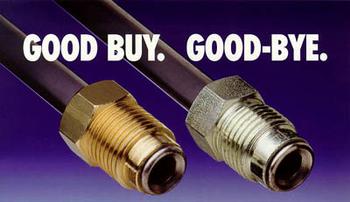In today's cost conscious component parts industry, the difference between a "good buy" and a "good bye" is often bottom line cost. In this case, free-cutting brass is 17% less expensive than its 12L14 steel counterpart!

It's simple math. While up-front costs for brass may be higher, once you factor in machining costs (brass is up to five time more machinable), turnings value (steel scrap is worthless), and the need to plate steel (brass naturally resists corrosion) - the bottom-line cost for free-cutting brass is significantly lower per finished part.

After only 314 hours exposure to salt-spray (fog) corrosion testing (ASTM B 117), the zinc-coated steel fitting (right) failed to meet customer specification.
And is doesn't stop there. As automakers extend warranty warranty periods and cover additional systems, down-the-road costs to remove rusted, corroded steel parts can be significant. As the photo above shows, brass stands the test of time far better than zinc-coated steel.
| C36000 | 12L14 Steel | |
|---|---|---|
| $92.46 | Raw Material Cost | $35.92 |
| -44.84 | Scrap/Turnings Value | +0.00 |
| $47.62 | Net Raw Material Cost | $35.92 |
| +28.44 | Cost of Machining | +47.78 |
| +0.00 | Zinc Electrocoating | +6.09 |
| $76.06 | Total Finished Parts Cost | $91.79 |
| * Based on June 1994 costs. | ||
For information on vendor sourcing and whatm akes free-cutting brass the "good buy," call the Copper Development Association at 800-CDA-DATA.
